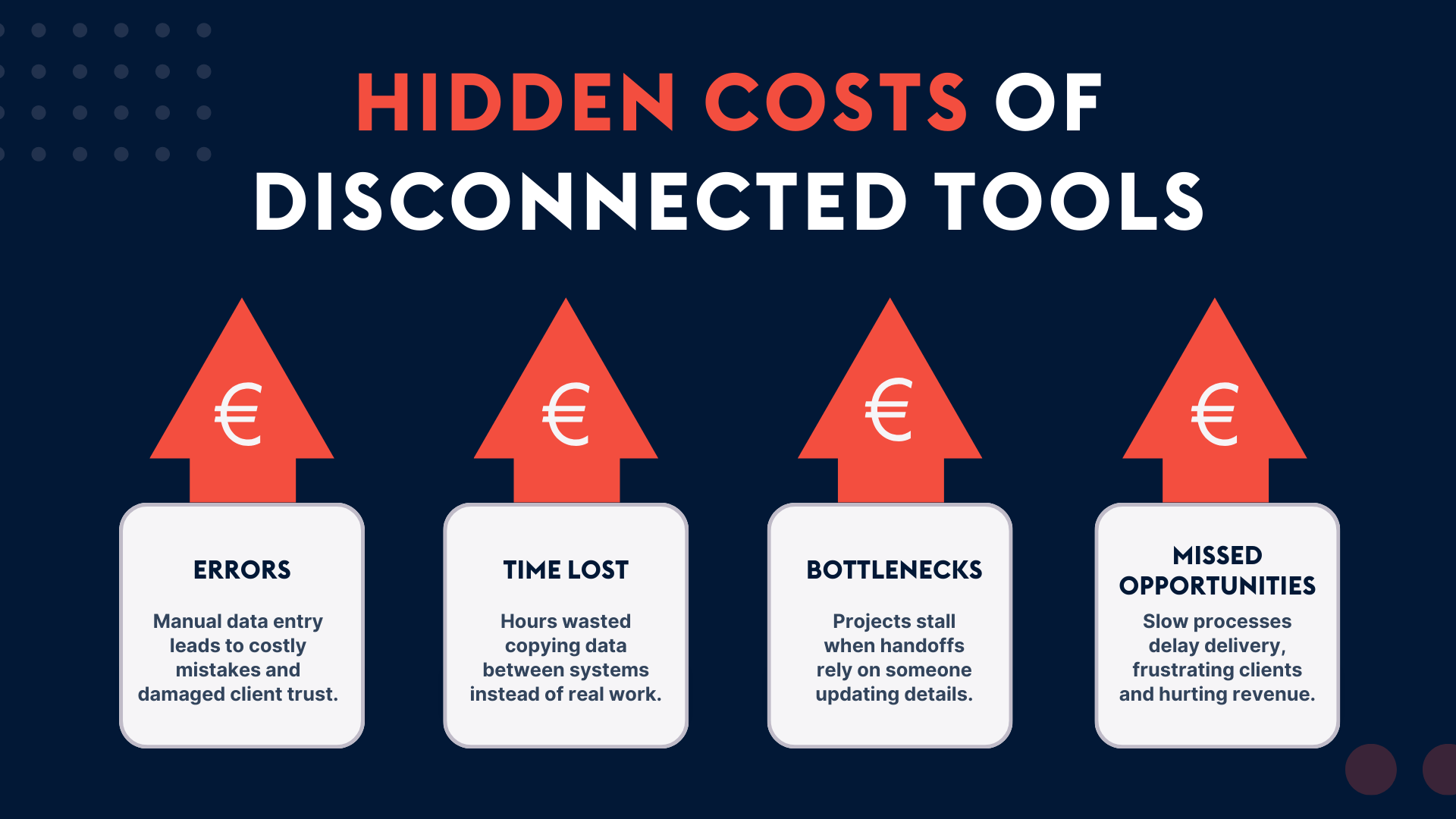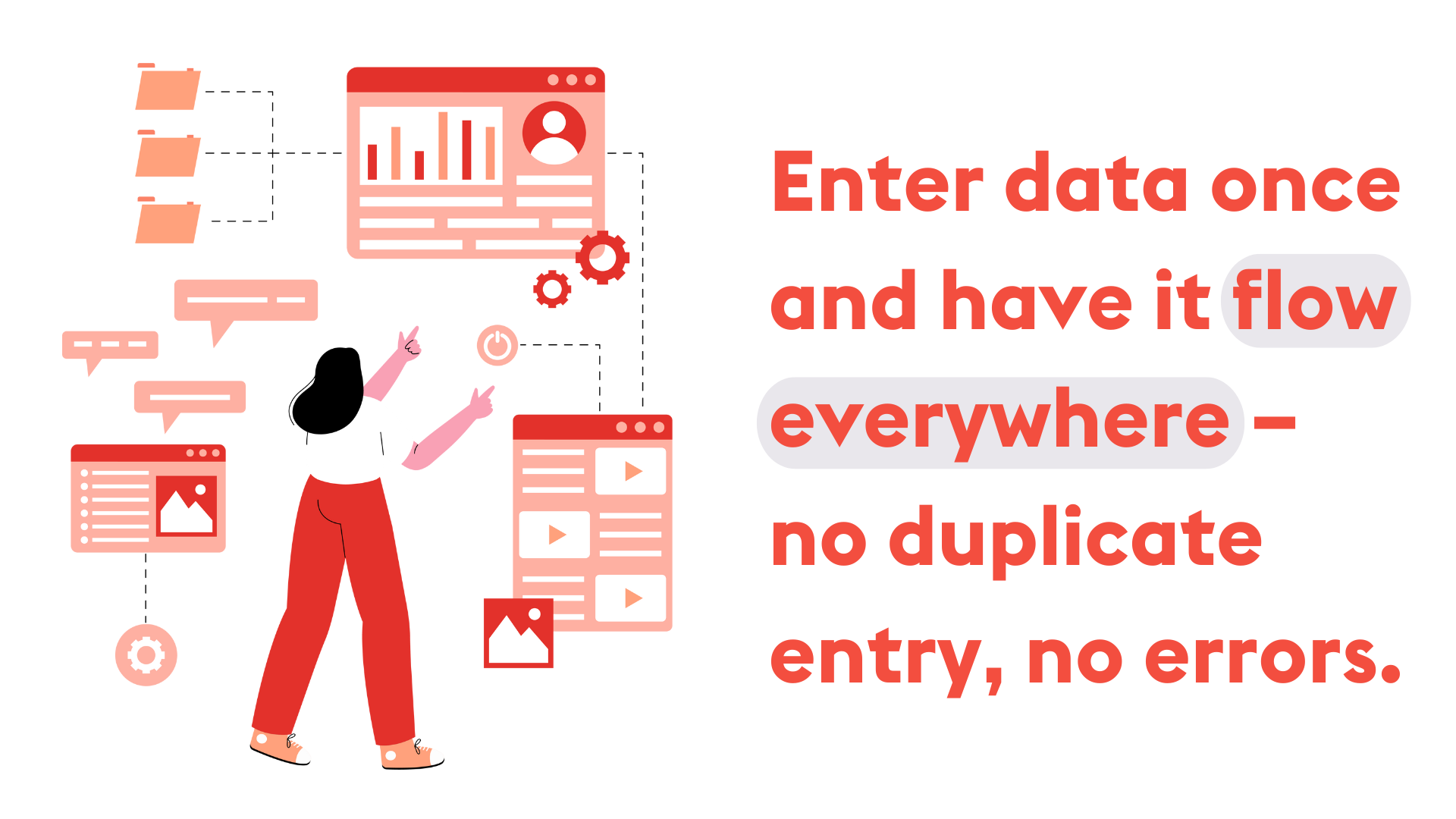
Modern businesses run on apps.
You’ve got SugarCRM to manage your sales pipeline. monday.com to keep projects moving. Xero to handle invoicing.
Individually, they’re powerful business tools. But they don’t natively talk to each other.
Instead of streamlined workflows, teams waste time manually copying data between systems. Opportunities are closed in one platform but not handed off properly to the next. Invoices are delayed because someone has to re-enter details that already exist elsewhere. And every manual step is another chance for errors to creep in.
At Provident CRM, we help teams connect the dots. Companies come to us after investing in excellent tools—only to find those tools are creating friction instead of flow. We use platforms like Make to eliminate busywork, reduce human error, and get your systems working as one.
The result? Faster processes, happier teams, and more time spent on high-value work.
In this article, you’ll learn:
Organisations adopt tools to keep teams organised and streamline workflows. A typical setup might include SugarCRM for sales, monday.com for project management, Xero for invoicing, and perhaps Slack or Teams for internal communication. Individually, these apps work well. But when they operate in silos, they create extra work.
One client, for instance, was juggling five systems—SugarCRM, monday.com, Xero, a time tracking tool, and a separate reporting dashboard. Each new deal meant copying the same data across multiple platforms. Staff were spending hours each week on manual updates rather than focusing on meaningful, high-value work.
It’s not unusual for us to find teams that have created entire workarounds just to handle data entry between systems. This isn’t just costly—it’s unnecessary. Automation can eliminate these repetitive tasks entirely.
The challenges caused by disconnected apps go beyond frustration. They impact productivity, accuracy, and even customer experience.
Here are the three most common problems we see with clients:
Human error is inevitable when people are tasked with manually moving data between systems.
A single mistyped phone number, an extra zero in a quote, or an incorrect date can cascade into bigger issues—incorrect invoices, delayed deliveries, or miscommunication with clients.
One client told us how a small typo in a project cost led to an invoice that was off by several hundred euros.
Because the data had been manually entered multiple times—first in monday.com, then in Xero—nobody caught the error until the client flagged it.
Correcting the mistake required reissuing the invoice and a lengthy back-and-forth, damaging trust and wasting time.
Transferring information between systems is tedious and time-consuming.
What might seem like a simple task—copying project details from monday.com to Xero—can take 10 minutes.
When you multiply that by multiple projects, multiple team members, and multiple systems, the wasted time adds up.
We worked with a client whose finance team was spending up to five hours per week on manual invoicing alone.
By automating their workflows between monday.com and Xero, we reduced this to less than 30 minutes per week, freeing them to focus on forecasting and strategic finance tasks instead.
Disconnected systems create bottlenecks.
A project team might be ready to start work but can’t move forward because the sales team hasn’t yet transferred the customer details into monday.com.
In busy companies, these delays can snowball, pushing deadlines back and frustrating both staff and clients.
We’ve seen cases where projects were delayed by several days simply because the handoff between CRM and project management relied on someone being available to manually transfer data.
With automation, this entire handoff can be triggered instantly, removing the dependency on human availability.

At Provident CRM, we use Make to bridge the gaps between systems.
Make acts as a powerful automation engine, allowing us to build workflows that move data between tools like SugarCRM, monday.com, and Xero automatically.
Here’s a common scenario we see:
→ A salesperson closes a deal in SugarCRM.
→ This automatically triggers Make to create a project in monday.com.
→ The project team manages delivery entirely within monday.com.
→ Once the project is complete, Make pushes all relevant data to Xero to generate an invoice—no manual entry required.
This kind of end-to-end automation reduces errors, saves time, and ensures that your Sales, Delivery, and Finance teams have the most up-to-date information.
The impact of automation is felt across the business.
It’s not just about saving time—it’s about enabling teams to work smarter, collaborate better, and serve customers faster.
Here are the key benefits we’ve seen:
One of the most immediate benefits our clients notice is the time saved.
Tasks that previously took 10–15 minutes are completed in seconds. For finance teams, this often means sending invoices on the same day a project is finished, rather than days later.
In one project, we implemented automation that cut a client’s invoicing process from 40 clicks across three systems down to just one button.
The time saved allowed the finance team to process twice as many invoices in the same period—without extra staff.
Automation ensures that once data is entered correctly in one place, it flows seamlessly through all other systems. There’s no need for staff to duplicate data entry or double-check that everything matches.
For one client, we built a workflow where entering details in SugarCRM automatically created corresponding entries in monday.com and Xero.
The result? A single source of truth for all customer, project, and billing information.
Automation significantly reduces human error. As long as the original data is correct, the systems will stay in sync. This is especially important for invoicing, where even small mistakes can lead to payment delays.
We’ve had clients tell us that after implementing automation, error-related rework dropped by over 90%. This builds confidence both internally and with clients.
Automation also breaks down silos between departments. Sales teams no longer need to email the delivery team with customer details—those details flow automatically. Finance teams don’t have to chase updates—they can see project status in real time.
By ensuring everyone is working with the same data, automation improves communication, speeds up handoffs, and fosters a more collaborative environment.

When clients hear the word ‘integration,’ they often assume it’s a huge IT project that will take months. In reality, many workflows can be set up in a matter of days.
We often start with a simple proof of concept, showing how Make can move data between two systems with just a click. This helps clients see the potential before committing to a full rollout.
Depending on the complexity, we can often implement a full CRM-to-project-to-invoice workflow in under a week. For simpler cases, it’s as quick as two days.
As a Platinum monday.com partner, we know the platform inside and out. Combined with our expertise in Make and SugarCRM, we can design and build integrations that are both robust and easy to maintain and evolve.
At Provident CRM, every integration project starts with one thing: deep understanding.
Our process always starts with a discovery call. We take the time to understand your business processes, map out pain points, and identify the best opportunities for automation.
We then design workflows that fit seamlessly into how your team works—eliminating friction rather than adding it.
We also focus on training and onboarding. Once an integration is in place, we provide clear documentation and video walkthroughs, and if needed, we offer live training sessions to ensure every team member is confident using the new system. We also provide ongoing support as your business evolves.
In other words: You can focus on your role—we’ll take care of the rest.
Disconnected apps don’t just slow your business down—they hold it back. With automation, you can free your teams from repetitive admin, reduce errors, and create a seamless flow of data from sales to delivery to finance.
If your team is stuck copying and pasting information between systems—or if you’re simply looking for ways to work smarter—now is the time to act. Contact us today via the link below to learn how Provident CRM can help you design an automation roadmap, connect your systems, and unlock the full potential of the tools you already use.